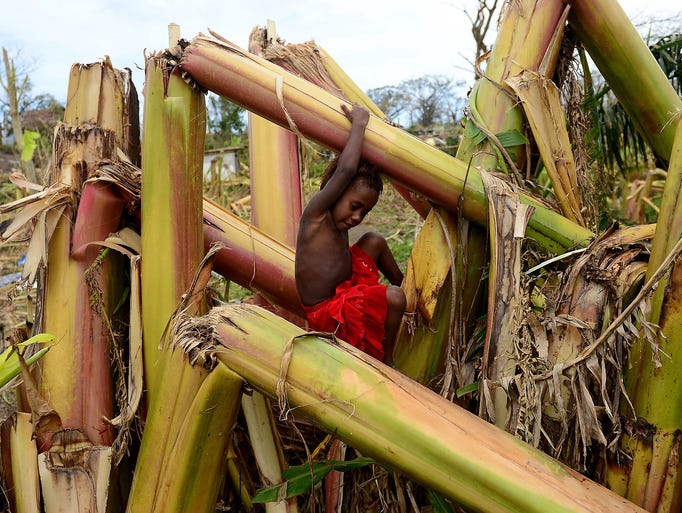
A boy plays in a banana plantation destroyed by Cyclone Pam on March 19 in Mele, Vanuatu. The Category 5 storm struck on March 14, causing widespread damage on many islands in the South Pacific nation. Jeremey Piper, AFP/Getty Images
Preparatory talks ahead of the United Nations Conference on Climate Change to be held in Paris in December has representatives from developing nations asking for more than an already agreed upon $100 billion per year for climate change mitigation measures. They want additional compensation for weather-related disasters as well as a “displacement coordination facility” for refugees. And they want all this to be legally binding as part of the larger anticipated Paris accord.
The U.S. and wealthier nations in the European Union are balking.
The rationale for the additional funds and refugee facility is based on donor country failures to follow through cohesively on aid pledges following weather-related disasters. For example, last March, Cyclone Pam devastated islands in the South Pacific but attention quickly turned to the massive earthquake in Nepal soon thereafter. That left small nations such as Vanuatu, which was devastated, to manage its own cleanup without much in the way of international assistance.
Poorer nations blame extreme weather-related disasters on climate change stemming from emission-polluting countries that have more developed and wealthier economies.
The U.N. Paris conference aims to reach an international, legally biding agreement on climate change that would reduce greenhouse gas emissions and thwart global temperature rise. A separate agreement is being eyed to address losses and damages from extreme weather events, thought to be a result of climate change.
As it stands, the Warsaw Mechanism, adopted in 2013 at the U.N. climate conference in Poland, established a structure to address losses and damages associated with climate change impacts. However that mechanism is due to expire this year when a new climate agreement is reached. Poorer nations who say they are on the front lines of climate change and suffer the worst of its extreme weather ramifications aren’t pleased by the expiration. They want loss and damage provisions to be extended and expanded upon.
Reports indicate a compromise will be sought whereby the Warsaw Mechanism is extended, yet carved out from any legally binding agreement.
Meanwhile, environmental groups are lobbying to make reparations even more punitive and require polluting companies in the private sector to step up and also pay for extreme weather-related damages.
Adding climate refugees to those numbers may be too much for government representatives to take on at the moment. Without question, however, a refugee facility needs to be discussed if not negotiated, as do further compensation measures for poor countries.
The $100 billion-a-year-commitment by 2020 seems like a lot of money, but increasingly it isn’t looking like enough funding. With extreme weather events on the rise, so too will be the costs of cleanup and the tolls on people’s lives.






roflmfao! pay us for weather that no one can prove is caused by anyone or anything other than naturally occurring phenomenon.
No mention of HAARP? You would think that they don’t know that we know. But we know that they know that we know!!